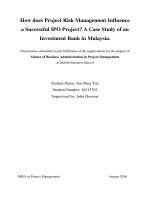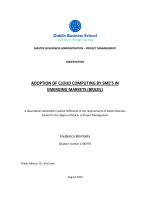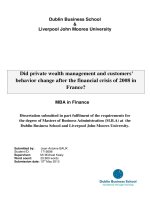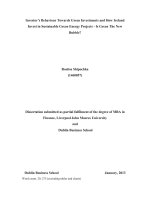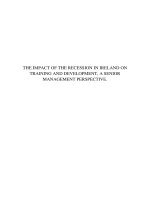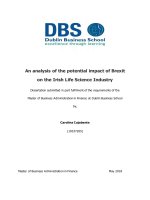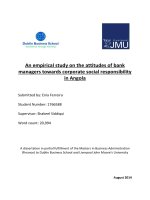Master Thesis in Economics: Investor’s Behaviour Towards Green Investments and How Ireland Invest in Sustainable Green Energy Projects - Is Green The New Bubble?
Bạn đang xem bản rút gọn của tài liệu. Xem và tải ngay bản đầy đủ của tài liệu tại đây (3.39 MB, 111 trang )
Investor’s Behaviour Towards Green Investments and How Ireland
Invest in Sustainable Green Energy Projects - Is Green The New
Bubble?
Rositsa Shipochka
(1460057)
Dissertation submitted as partial fulfilment of the degree of MBA in
Finance, Liverpool John Moores University
and
Dublin Business School
Dublin Business School
Word count: 20, 275 (excluding tables and charts)
January, 2013
Declaration:
I declare that the presented below dissertation is entirely my own and which I now submit
for assessment on the programme of study leading to the award of Masters of Business
Administration in Finance. No part of this work has been previously submitted for
assessment for any academic purpose to Dublin Business School or any other institution.
Signed:..............................
Date:.................................
2
Table of content
List of Figures…………………………………………………………………………..7
Acknowledgements …………………………………………………………………….8
Abstract.………………………………………………………………………………..9
Chapter 1 – Introduction……………………………………………………………..10
1.1 The research problem……………………………………………………………….10
1.1.1 Kyoto Protocol…………………………………………………………....10
1.1.2 Investments……………………………………………………………….11
1.1.3 What is Green Investment……………………………….………………..11
1.1.4 What is ethical investment………………………………………….…….12
1.2 Interests in the topic……………………………………………………………..….12
1.2.1 Research questions and objectives………………………………………..12
1.2.2 Research hypothesis……………………………………………………....13
1.3 Contribution of the research…………………………………………………….…..14
1.4 Approach to the research…………………………………………………………....14
1.5 Organisation of the research………………………………………………………...14
1.6 Limitations of the research……………………………………………………….…15
Chapter 2 - Literature review…………………………………………………….…..16
2.1 Introduction………………………………………………………………………...17
2.2 Green Investments……………………………………………………………….....18
2.3 Ethical and SRI Investments…………………………………………………….….22
2.4 Government Policy…………………………………………………………….……27
3
2.4.1 Irish Policies for Green Investments…………………………………...28
2.4.2 International Policies……………………………………………………30
2.5 Impact of the Financial Crisis on the Green Investments………………………...32
2.6 Profits from Green Investments…………………………………………………..34
2.7 Conclusion………………………………………………………………………...38
Chapter 3 - Research Methodology…………………………………………………39
3.1 Introduction……………………………………………………………………….39
3.2 Research Philosophy………………………………………………………………42
3.2.1 Positivism………………………………………………………………..43
3.2.2 Realism………………………………………………………………..…43
3.2.3 Pragmatism………………………………………………………………43
3.2.4 Interpretivism……………………………………………………………44
3.3 Research Approach………………………………………………………………..44
3.3.1 Deductive research approach………………………………………………...45
3.3.2 Inductive research approach…………………………………………………45
3.3.3 Abductive approach………………………………………………………….46
3.4 Research Design…………………………………………………………………...47
3.4.1 Mono method……………………………………………………………47
3.4.2 Multi –method…………………………………………………………...47
3.5 Research Strategy………………………………………………………………….48
3.5.1 Grounded Theory………………………………………………………...49
3.6 Research Techniques and Procedures……………………………………………..50
3.6.1 Secondary data………………………………………………………......50
3.6.2 Primary data……………………………………………………………..51
3.7 Time Horizons……………………………………………………………………..51
4
3.8 Population and Sample……………………………………………………………52
3.8.1 Probability sampling………………………………………………….....53
3.8.2 Non-probability sampling……………………………………………….53
3.9 Ethical Issues……………………………………………………………………...54
3.10 Conclusion……………………………………………………………………….54
Chapter 4 - Data Finding and Analysis……………………………………………..55
4.1 Introduction……………………………………………………………………….55
4.2 Findings……………………………………………………………………………55
4.2.1 Objective 1 Findings and Analysis………………………………………56
4.2.2 Objective 2 Findings and Analysis………………………………………58
4.2.3 Objective 3 Findings and Analysis………………………………………59
4.2.4 Objective 4 Findings and Analysis………………………………………61
4.2.5 Objective 5 Findings and Analysis………………………………………65
Chapter 5 – Conclusion………………………………………………………………68
Chapter 6 - Self Reflection on Own Learning and Performance………………….72
6.1 Introduction………………………………………………………………………..72
6.2 Learning Styles based on Kolb‟s Model…………………………………………...72
6.3 Learning Styles based on Honey and Mumford…………………………………...75
6.4 Personal Development Objectives…………………………………………………76
6.4.1 Time management…………………………………………………………...76
6.4.2 Communication skills………………………………………………………...77
6.5 Personal and Professional Goals…………………………………………………....77
6.6 Influences for selection of the research topic………………………………………78
5
6.7 Conclusion………………………………………………………………………….78
Bibliography and References………………………………………………………...80
Appendix 1 Definition of Thematic Investment…………………………………….88
Appendix 2 Interviews…………………………………………………………..88- 111
6
List of Figures
Figure 2.1: Multiple stages in investing in theme……………………………………….16
Figure 2.2: Breakdown of Cleantech Investment Market………………………………..17
Figure 2.3: The constituents of 21st century investment…………………………………19
Figure 2.4: Global Fossil Fuel Prices – Oil………………………………………………20
Figure 2.5: Global Fossil Fuel Prices – Oil……………………………………………....21
Figure 2.6: Global Fossil Fuel Prices – Coal…………………………………………….21
Figure 2.7: Global Fossil Fuel Prices - Natural Gas……………………………………..22
Figure 2.8: The multiple styles of sustainable and responsible investing……………….24
Figure 2.9: FTSE4Good Environmental Leaders Europe 40 Index……………………...32
Figure 2.10: Portfolio Inclusion Criteria by KFW……………………………………….35
Figure 2.11: Annual Returns MSCI World and MoRE World…………………………..36
Figure 2.12: NYSE BNEF Global Clean Energy Sector Indexes………………………..37
Figure 3.1: Differences between Quantitative and Qualitative Data…………………….40
Figure 3.2: The Research Onion…………………………………………………………41
Figure 3.3: Competing Paradigms in Qualitative Research……………………….……..42
Figure 3.4: Sampling Methods…………………………………………………………...53
Figure 4.1: The percent of investment made in Irish Companies and Projects…………..62
Figure 6.1: Kolb‟s Learning Style………………………………………………………..73
Figure 6.2: Honey and Mumford model………………………………………………….75
Appendix 1 Definition of Thematic Investment………………………………….87
7
Acknowledgements
First of all I would like to thank my dissertation supervisor Ann Masterson for all
the help and support throughout the whole research process and especially for organising
certain events, when we have started working together. I would also like to thank Dr
Chris McLaughlin for his help with formulating this topic, and all the lecturers and staff
from Dublin Business School for making this experience possible.
Second of all I would like to thank my family for their love and encouragement,
my boyfriend for providing me with valuable connections and all friends and colleagues
for their continuous support.
8
Abstract
The purpose of this research is to analyse the attitudes and believes of Irish
investors towards green and ethical investments. Why they invest in green, is it profit
maximisation or ethical considerations and what are the barriers for green investments.
How feasible is the government policy and targets set for greening the Irish economy by
2020. The green and ethical investments became very popular as thematic investments in
the past couple of decades, driven by the growing concern for the environment, growing
world populating and the depletion of the supply of the finite natural resources. Green
and ethical investments are driven by politics, demographics and cultural factors however
in resent years some of the leading global companies have adopted ways for switching
towards sustainable practices and efficient use of energy and natural recourses. The first
chapter provides introduction of he topic, the research questions and objectives. The
second chapter presents the literature review with more detail explanation of green and
ethical investments, followed by government policies, and the effect of the financial crisis
on the green sector in Ireland. The third chapter will present the research methodology
and methods proposed for this research and the research philosophy, approach and
strategy. Chapter four will present findings and analysis of the research, followed by the
conclusion in chapter six. The last chapter seven is reflection on learning.
9
Chapter 1
Introduction
1.1 The research problem
Over the past couple of decades environmental investments became increasingly
popular and increasing number of investors are exploring options that promise both longterm financial returns and promotion of social good. Emissions resulting from energy
production from the combustion of fossil fuels are the principle cause of global warming.
The climate developments in resent years and higher temperatures resulting in extreme
weather conditions and rising sea levels will likely disrupt governmental fiscal positions
Transition to low-carbon emissions economy in efforts to mitigate climate change will
require substantial investments in alternative or green energy sources, implementation of
costly policies and adopting behaviors for production in the new environment. Fossil
fuels however provide between 80%-90% of energy needs worldwide according to the
Green Investing guide (2011). International efforts to reduce greenhouse gas emissions
are currently organized under the United Nations Framework Convention on Climate
Change (UNFCCC) and the Kyoto Protocol.
1.1.1 Kyoto Protocol
In the case of global warming, perhaps one single external event attracted
increased attention and response is the ratification of the Kyoto Protocol. Under the 1997
Kyoto Protocol, which came into force in 2005, an agreement was put in place for
industrialized nations to limit greenhouse gas emissions below the levels of 1990 by year
2012 (Galbreath, 2011), which was extended to 2020 earlier this year. Ireland as well as
many other countries, and as part of commitment to EU regulations, is trying to reduce its
greenhouse gas emissions from and green its economy, by setting ambitious targets.
1.1.2 Investments
The nature of investments is to increase the stock of wealth of the business. The
uncertainty associated with the investments is whether the future outcome of the
10
investment will be profit or loss. High revenues and returns on investments and economy
of scale have been defined as the primary objectives for any business. However green and
ethical investments in recent years are becoming highly popular in the financial markets,
with substantial investment demand (Kimmel, 2010).
1.1.3 What is Green Investment?
Investment activities that focus on companies or projects that are committed not
only on the conservation of natural resources, but also focus on discovery and production
of alternative energy sources, execution of green water and air projects and
environmentally sensible business practices. “Pure play green investments are those that
derive all or most of their revenues and profits from green activities. Green investments
can also be made in companies that have other lines of business but are focusing on
green-based initiatives and product lines” (Clean Investing, 2009). The meaning of clean
energy investment is not only to address the ecological issues and the natural resources
depletion, but also the volatility of the prices of the traditional sources of energy and
increased concerns related to the nuclear energy. In this context the clean “green” energy
sources are becoming important element for sustained economic growth (Inderst et al,
2012)
There are two main areas for investments - environmental innovators and sector
leaders. Environmental innovators are in the business of solving the most pressing
environmental problems, companies whose goods or services are directly contributing to
a more sustainable future. Green energy technologies are becoming increasingly cost
competitive as they reach scale and operating experience. To further support the green
energy solutions policy makers need to build frameworks, which enable investors and
companies to make good returns on their investments and to start the transition toward a
clean world energy infrastructure. Over the past few years there has been substantial
interest in clean energy by venture investors, attracted by the size of the markets that will
be created, private equity investment continued also throughout the resent financial crisis.
Growing number of reports show that the green investments increased and also
diversified geographically, moving away from Europe, towards the countries that are
11
currently with the fastest growing economies such as Brazil, India and China.
1.1.4 What is ethical investment
Ethical investments refer to the practice of some investors of deciding which
financial securities to hold, based on whether the actions of the company that issued the
security are ethical, in the eyes of the investor (Hudson, 2005). By investing ethically the
individual investor‟s fulfills their duty to society in their acts of buying stocks and bonds
in ethical companies and selling those of non-ethical companies. Some ethical investors
may feel satisfied if they succeed merely in not profiting or in punishing or respectively
rewarding firms. The results of many empirical studies show that returns on ethical stocks
are not different from those on non-ethical stocks of the same level of systematic risk.
1.2 Interests in the topic
The researcher has interest in business ethics, environmental issues and finance
management and has been fascinated by the topic in terms, that the green investments
sector combines all three aspects. Given the importance of stable environment, as a base
for growth for any business, the researcher aims to determine how companies contribute
towards achieving stable environment by investing in green, whether ethical
considerations motivate investors to undertake green investments and what are the main
drivers and barriers for green investments in Ireland.
1.2.1 Research questions and objectives
The research questions the researcher is aiming to answer are: “What are the main
barriers and respectively the main drivers, stimulating investors to include green
investments in their portfolios?” and
“How feasible are the targets set from the
Government for greening the Irish economy by year 2020?”
In order to answer the research questions pointed above, the following objectives
were set for the research:
12
1. To outline the portfolio of Irish green investors and if they invest only in green
projects and companies.
2. To determine what motivate Irish investors to invest in green energy projects
and whether personal values or profit maximization is deciding factor for green and
ethical investments.
3. To determine whether green investment in Ireland outperform the traditional
investments.
4. To determine whether green-gap exist in Ireland between investors‟ intention
and action to invest ethically.
5. To determine the extent to which the resent financial and economic crisis has
affected green investments in Ireland.
1.2.2 Research hypothesis
In the process of achieving the research objectives and based on the research
questions the following hypothesis will be tested:
H1 Personal values and beliefs are deciding factor for green investors when
investment is considered.
H2 The way to overcome economic crisis is to invest in renewable energy where the
return on investments are higher and foreseeable in the long run.
H3 Future prices for renewable energy will be cheaper, as the sun, wind and water are
free.
H4 Green is the new bubble.
1.3 Contribution of the research
Given the importance of the pressing issues of global warming and the need for
13
boosting green investments, there is little academic research done in the area. This topic
links several different sectors financial, energy and national resources, and environmental
in joint efforts to try and reverse the damage of the heavy pollution, during the
industrialisation process over the last century, contributing to more efficient use of
natural resources and sustainable long-term returns on investments. Preventing future
financial crisis. As the title suggest this research will be looking at “How Ireland invests
in green energy and investors behavior towards green investments”. The aim of this
research is to partially fulfill this gap in the academic space and perhaps to give a seed for
future research.
1.4 Approach to the research
In order to answer the research question and achieve the set objectives for this
research primary as well as secondary research methods will be employed to gather valid
data. The use of secondary data from previous research done on this topic will help with
outlining the main themes emerging from the data and that will need further exploration
and also to build on robust literature review, as a base for the analysis and the conclusion
of the research. For the primary research face-to-face unstructured interviews will be
conducted to gather data from figures with various stakes in the green sector in Ireland.
Analysing the data collected from both the primary and secondary research the researcher
would be able to draw conclusions on how Ireland invests in green energy projects.
1.5 Organisation of the research
The first chapter of the research is the introduction, outlining the background of
the problem and the research question and objectives, also the hypothesis be tested. The
researcher interest in the topic and the contribution of the research for the academia, as
well as limitations of the research are also included in the introduction. The chapter
following the introduction is the literature review. The main focus on this chapter is to
review the research that was previously done on the chosen topic, and to present the
themes arising from the review. More detailed examination of the background of green
and ethical investments is included in the literature review as well as it is been supported
by previous research. Following is the Irish policy for green investments and the
14
international influence in the face of EU and UK, profiting from green investments and
how the resent financial and economic crisis affected those investments are the last part
of the literature review. Chapter three is the research methodology with more detail given
of the methods adopted for data collection, the sampling process, the philosophy,
approach and strategy of the research following the Research Onion used by Saunders et
al (2009), as framework to present the most suitable methods adopted for the research.
Following the methodology is chapter four finding and analysis chapter where the data
collected from the primary research will be presented and analysed against the data from
the secondary research following some discussions. Chapter five will draw conclusions
based on the data analysis of the primary and the secondary data and where the
hypothesis will be tested. Following this is chapter six, which is self-reflection of
learning, outlining the process of completing the dissertation and the effect and the
contribution that had on the researcher both in personal and professional level.
1.6 Limitations of the research
The main limitation of this research is population size. In the process of obtaining
the qualitative data the time available for the research was very limited, in terms that it
took some time for the respondents to reply to emails sent to them, when trying to arrange
the interviews. The response rate in general was very low, as well as some of the
respondents cancelled the interviews. The time could influence the research in ways such
meeting deadline given for the project completion and the interviewees may have limited
time to spare for the interview. Further more, the interviewees may not be able to reply
to certain answers to the particular interview question due to the questions being too
specialized. Interviews can be a time-intensive evaluation activity because of the time it
takes to conduct interviews, transcribe them, and analyse the results.
15
Chapter 2
Literature Review
2.1 Introduction
Over the past few decades‟ dramatic growth in population and consumption of
natural resources in every continent, increased the need to be thinking how we can
continue to survive and grow without consuming our planet. Only recently opportunities
to invest in green emerged (Kimmel, 2010). In resent research green investments have
been described as “the most recent investment niche to emerge from the larger socially
responsible investment theme, with more emphasis towards environmental issues”
(Chang, 2012). Green investments are made in companies, which are taking measures to
minimize their carbon footprint or the resources used in the production process and also
in companies that produce green energy or ecologically friendly products.
Figure 2.1: Multiple stages in investing in theme
Source: Citi Investments Research and Analysis
16
The figure above shows the different stages on investment in theme, where the
equity investors investing in all parts of the chain and the debt investor typically focusing
on Project Debt.
According to the (Clean Investing, 2009) report “environmental innovators can be
found in many industry sectors, including: sustainable agriculture and natural food
supply; renewable energy and energy efficiency; water treatment and conservation; air
pollution control and prevention, and recycling technologies”.
Figure 2.2: Breakdown of Cleantech Investment Market
Source: Bloomberg New Energy Finance
17
2.2 Green Investments
Based on the publications made in the Green Investing report (2011), in the years
after the recent financial and economic crisis, investments in the green energy sector
increased to approximately US$ 250 billion per annum, however this is only half through,
of what the set targets were, meaning that there is financing gap of US$ 250 billion per
annum. “Given the long-term importance of growing the clean energy sector to both help
address climate change and provide alternatives to traditional sources of energy, policy
makers will need to find ways to make clean energy available at the lowest possible cost”
(Galbreath, 2011) and (Green Investing, 2011).
The literature suggests that the main area of response from companies is, in attempts
to reduce greenhouse gas emissions. Study of the FTSE -100 (London Stock Exchange)
listed companies shows that the largest part of the companies are investing in actions,
either technology-orientated or process-oriented aiming to reduce the extent to which
they emit carbon dioxide (Galbreath, 2011). There re two headlines within the
environmental opportunities: FTSE EO All-Share Index includes all the companies that
meet the inclusion criteria and have significant involvement in environmental business
activities. The other headline is FTSE EO 100 focus on the top ten largest companies by
market capitalisation included in the FTSE EO All share index (FTSE).
Several authors argue, that another reason for the recognition and the growing interest
of the sustainable investment sector is that the traditional investments fail to take into
account the increasing environmental issues (Robins and Krosinski, 2009), (Kennedy,
20212). In terms of green investments made by individual investors and households,
resent research shows that behavioral determinants such as attitudes, beliefs and social
norms, are often neglected by policy makers (Claudy and O‟Driscoll, 2008). The authors
further explain that, in the literature covering investments in energy conservation suggest,
that such investments are motivated by conviction rather than economics. When
purchasing such domestic energy conservation systems the individual investor has direct
impact on the environment, reducing its carbon emissions and eventually reduces the
energy consumption. The effects of such actions will only be notable, however when the
18
number of such investments is greater (Claudy and O‟Driscoll, 2008). One of the most
notable barriers in the case of household investments is limited access and high interest
rates of the capital required for the initial investment.
Figure 2.3: The constituents of 21st century investment
SUCCESSFUL INVESTMENT
Depend upon
IDENTIFYING TARGETS WHICH CAN
PROVIDE A GOOD RETURN
Which depends upon
A VIGOROUS POPULATION
OF ENTERPRISES
Which depends upon
A HEALTHY MACRO ECONOMY
Which depends upon
A HEALTHY CIVIL SOCIETY
Which depends upon
A SUSTAINABLE PLANET
Source: Centre for Tomorrow’s Company (2000)
Green investment in solar power remains the market leader and the most accessible
option for private investors, interested in such opportunities for European Countries
(Green Investment Guide, 2011). According to a recent study (Diffney et al, 2009) the
author argues, “for a small and relatively isolated market such as Ireland, a high
penetration of wind is economically sound only if it is accompanied by an increase in
interconnection to Great Britain”. For the implementation of such joint effect of building
19
wind farms, large level of investment will be required in the energy sector for further
upgrades of transmission and distribution lines. To stimulate such investments capital
costs must be kept down (Diffney et al, 2009).
There are expectations for the prices of the green energy are that will decrease in the
next ten to fifteen years, which will give a competitive edge of the green energy sector
over the traditional fossil fuels such as coal, oil and natural gas. Schwabe (2009) argues
that there are “opportunities for early investors, which understand the green market and
invest logically to capture unparalleled profits”. Investors engaging with the green sector
will discover the tremendous potential of the alternative energy industry and learn how to
find companies within it that are positioned for a long and lucrative run. Investing in
renewable energy or generating electricity is totally different from other energy
enterprises in that, that it is highly regulated and its product cannot be stored, also green
energy is highly priced compared to the lower price of natural gas. These are currently
some of the challenges facing the green energy sector.
Figure 2.4: Global Fossil Fuel Prices - Oil
Source: International Energy Agency, Key World Energy Statistics 2010
20
Figure 2.5: Global Fossil Fuel Prices - Oil
Source: WTRG Economics
Figure 2.6: Global Fossil Fuel Prices - Coal
Source: International Energy Agency, Key World Energy Statistics 2010
21
Figure 2.7: Global Fossil Fuel Prices - Natural Gas
Source: International Energy Agency, Key World Energy Statistics 2010
The presented above several charts are adopted from the IEA statistics and
reflecting the performance in the prices of the natural energy resources or fossil fuels.
Over the past twenty-five years is observed gradual increase in the fossil fuel prices with
a peak in the years before the financial crises, followed by slight decrease in the
economic downturn. According to (Schwabe, 2009) as stated above, such decrease of the
prices of the fossil fuels could make renewable energy prices unattractive. The prices for
renewable energy generated however are not as volatile. The graphs will be concerned in
the building of the theory to test the hypothesis.
2.3 Ethical and SRI Investments
As one of the major investment trends in resent years according to the Chairman
of the United Nations Principle for Responsible Investment was the integration of the
environmental, social and corporate governance into investment analysis and stewardship
(FTSE4Good, 2011).
The investor‟s decisions whether to invest ethically or not can significantly
change their lives and also the lives of others involved. To be able to make ethical
decision one need to understand first how other people make ethical decisions
22
(Woiceshyn, 2011). From business point of view making unethical decision could have
serious implications to any of the stakeholders of the business argues (Williams, 2005).
There is a growing body of literature on ethical investment across a range of
disciplines. (Pasewark and Riley, 2009, Woiceshyn, 2011, Williams, 2005, Hudson, 2005,
Goyen, 2005, Soderbergh, 2004, Robins and Krosinski, 2009, Nilsson, 2007, Glac, 2008,
Beal et al 2005, Jones et al, 2007, Lewis, 2001, Lewis & Mackenzie, 2000a)) “Ethical
investment is defined as the integration of personal values, social considerations and
economic factors into the investment decision” (Michelson et al, 2004). Williams, (2005)
define the SRI as investments process that considers the positive and negative social and
environmental consequences of the investment the investors based on “rigorous financial
analysis”.
Past performance of ethical investments and the ethical investment market sentiment
are other factors that influence the investment decisions. Ethical investors choose to buy
stocks that meet some ethical criterion based on standard methods of investment returns
(Williams, 2005 and Yang et al, 2007) and they divest themselves of stocks that fail to
meet the criterion. Investors can research stocks themselves, or they can buy into ethical
mutual funds, offered by many investment firms. In all cases, someone does research on a
company‟s activities to see, if they pass or fail some ethics test (Hudson, 2005).
There has been increase in the number of ethical funds trusts. The Ethical Investment
Cooperative in the UK for instance, states itself to be a democratically run organization
which provides clients with quality ethical, financial planning advice in a manner that
gives clients a chance to say what happens to their investments and that helps them to
change corporate attitudes (Hellsten, 2006). There is a range of ethical funds in Ireland
for Investors who wish to invest ethically, whether based on exclusionary models or
thematic ones with green focus. The performance of the ethical funds shows that they
such investments can be financially valuable for investors (Kennedy, 2012).
23
Figure 2.8: The multiple styles of sustainable and responsible investing
STRATEGY
Ethical Exclusions
Positive screening
Best-in-class
Pioneer screening/
Thematic investment
propositions
Norms-based screening
Simple screens/
Simple exclusions
Engagement
Integration
DEFINITION
This refers to exclusion where large number of negative
criteria and/or filters are applied (as opposite to just
tobacco or weapons, etc.).
Seeking to invest in companies with a commitment to
responsible business practices, or that produce positive
products and/or services. Includes Best-in-class and
Pioneer screening.
Approach where the leading companies with regard to
SEE criteria from each individual sector or industry
group are identified and included in the portfolio.
Thematic funds based on ESG issues such as the transition t
sustainable development and low carbon economy. May
focus on sectors such as Water, Energy, etc.
Negative screening of companies according to their
compliance with international standards and norms
such as issues by OECD, ILO,UN, UNICEF, etc.
An approach that excludes a single given sector from a
fund such as arms manufacture, animal testing, tobacco
Simple screens also includes simple human rights
screens and Norms-based screening.
Engagement is applied by some fund managers to
encourage more responsible business practices and/or
enhance investment returns. It relies on the influence of
investors and the rights of ownership and mainly takes
the form of dialogue between investors and companies
on issues of concern. Engagement may extend to voting
practices.
The explicit inclusion by asset managers of CG/ SEE risk
Into traditional financial analysis.
Source: European SRI Study 2006
24
The finance discipline of the past decades has developed the bases that the rational
for investors is that, their preference is for higher returns, to compensate them for
assuming higher risk.
“In short, the traditional theory does not allow for any
influences on the investment decision apart from maximizing returns given the
constraint of the individual‟s particular level risk aversion” (Goyen, 2005,).
Financial return remains an important outcome, but is not the only deciding factor
when undertaking investment. It is worth examining the processes, by which the
business people and investors make their decisions and how these processes affect the
outcome, whether to invest in ethical or unethical projects. According to (Rivoli,
2005) however, it is necessary to distinguish clearly between the ethical, social and
the economic motives of investors. From the ethical perspective the decision will be
made based on the investor‟s judgment whether the course of action is right or wrong.
The economic decision will be made based on the financial outcome or whether the
investment will be profitable or not (McLachlan and Gardner, 2004). Important thing
to remember in investing is successfully balancing out the risk-reward equation
argues (Hughes, 2010). And according to neoclassical economic theory, ethical
investment should not prevail in financial markets (Hofmann, 2007). Ethical investors
live a lifestyle consistent with their values. Gender and age are related to ethical
investment and the percentage of women, who are interested in ethical investment, is
higher than the percentage of male conventional investors based research by
(Williams, 2005).
Study conducted among Spanish investors and financial consultants, has
highlighted that the percentage of committed ethical investors is marginal, where the
ethically aware group is representing forty per cent of the total sample, which “would
invest ethically as long, as profitability does not decrease significantly” (Valor et al,
2008). In the UK studies have not found differences in age, gender or income (Lewis,
2002), although a study by EIRIS (1999) (sited in Valor et al, 2008) found that
women and the segment of 45 to 55 year olds were more likely to favor ethical
criteria over financial returns. Williams, (2005) reject the hypothesis that the SRI
investors will be younger in compression to the traditional investors, based on his
research of comparison of SRI and traditional investors in six countries. In fact, based
on the research the SRI investors in Germany are significantly older. Australian
25

